Smart Tactics To Minimize Cart Abandonment And Boost Conversions In 2025

In today’s digital economy, getting customers has become increasingly competitive. You spend a lot on marketing, advertising, and promotions. All this effort is to get potential buyers to your website or app. Even after adding items to their cart, many customers still leave without completing their purchase. This is called cart abandonment. It is a big challenge for your business.
So let’s see why it happens and how you can reduce it.
What is Cart Abandonment?
Cart abandonment happens when a customer adds products or services to their cart and leaves the website or app without completing the purchase. The customer is clearly interested. But various obstacles can stop them from completing the process. You can think of these interruptions in three stages. They are pre-checkout, during checkout, and after checkout.
1. Pre-Checkout Challenges
The pre-checkout phase covers all interactions before the customer reaches the payment page. Common reasons for cart abandonment at this stage include:
- Mandatory account creation: Being forced to create a new account can frustrate users. Offering a guest checkout option allows the customer to complete their purchase quickly.
- Lack of product information: Make sure your product pages are easy to understand. Include clear descriptions, FAQs, and other helpful options.
- Unclear return policies: You should make your policies clear and easy to understand. Explain the steps customers need to follow to get a refund. This helps them to build their trust and confidence in your business.
- Long delivery times: Show your customers how long processing and shipping will take. It can make your customers feel more confident about buying.
- Poor user experience: Make sure your app or site’s interface is tested regularly. Improve its speed and responsiveness. Fix any errors as soon as they appear.
- Out-of-stock items: You can show them the stock levels clearly on your product pages. It makes the process easier for them. You can also collect their email addresses so you can notify them when the items are back in stock.
2. Checkout Challenges
When a customer reaches the checkout page, finishing the purchase depends a lot on how easy and trustworthy the process feels. Key factors here include:
| Challenge | Impact | Solution |
| Additional/unexpected costs | High extra charges can surprise and discourage customers. | Disclose all fees upfront, offer free shipping, or provide discounts. |
| Complex checkout | Multi-page flows frustrate users. | Simplify the process, implement one-click checkout, and allow wallet linking. |
| Preferred payment method unavailable | Customers abandon carts if their payment choice is missing. | Offer local and alternative payment methods suitable for your target audience. |
| Security concerns | Fear of data misuse causes drop-offs. | Ensure SSL, PCI compliance, and display trust signals prominently. |
| Inconsistent checkout design | Disjointed experience raises doubts. | Align checkout design with the website/app branding for a seamless experience. |
Streamlined checkout experiences are essential for keeping customers engaged. Offering saved payment options or “QuickPay” features allows returning buyers to complete purchases swiftly, reducing friction and improving conversion rates.
3. Post-Checkout Challenges
Even after the payment step is initiated, failures can lead to abandoned carts:
- False declines: Legitimate transactions can be mistakenly blocked, frustrating customers. Implement fallback retry mechanisms to route payments to alternative processors automatically.
- Payment service downtime: Technical failures can interrupt transactions. Dynamic routing to the best-performing service providers and fallback routing strategies ensure higher success rates and reduce drop-offs.
The Impact of Cart Abandonment on Businesses
High cart abandonment rates affect more than just immediate sales:
- Revenue loss
- Skewed marketing costs
- Inventory mismanagement
- Brand perception
Tactics to Reduce Cart Abandonment
- Reduce friction: Make the checkout process simple for your customers. Remove unnecessary steps, give them guest checkout, and use one-click flows.
- Build trust: Keep the checkout experience consistent and familiar for your customers. Follow all data protection rules to keep information safe.
- Offer diverse payment options: Provide multiple payment methods to find your customers’ preferences.
- Enhance payment reliability: Make sure your payment system is strong and reliable. This helps prevent transactions from failing. Use smart routing and backup options to keep payments smooth for customers.
Summing up
Cart abandonment is a big challenge for any business. It can reduce revenue and affect how happy your customers are. By understanding the phases, you can apply practical solutions to convert abandoned carts into successful transactions.
Reducing cart abandonment is more than just fixing operations. It is a smart strategy you can use to grow your business and build loyal customers for the long term in 2025.





